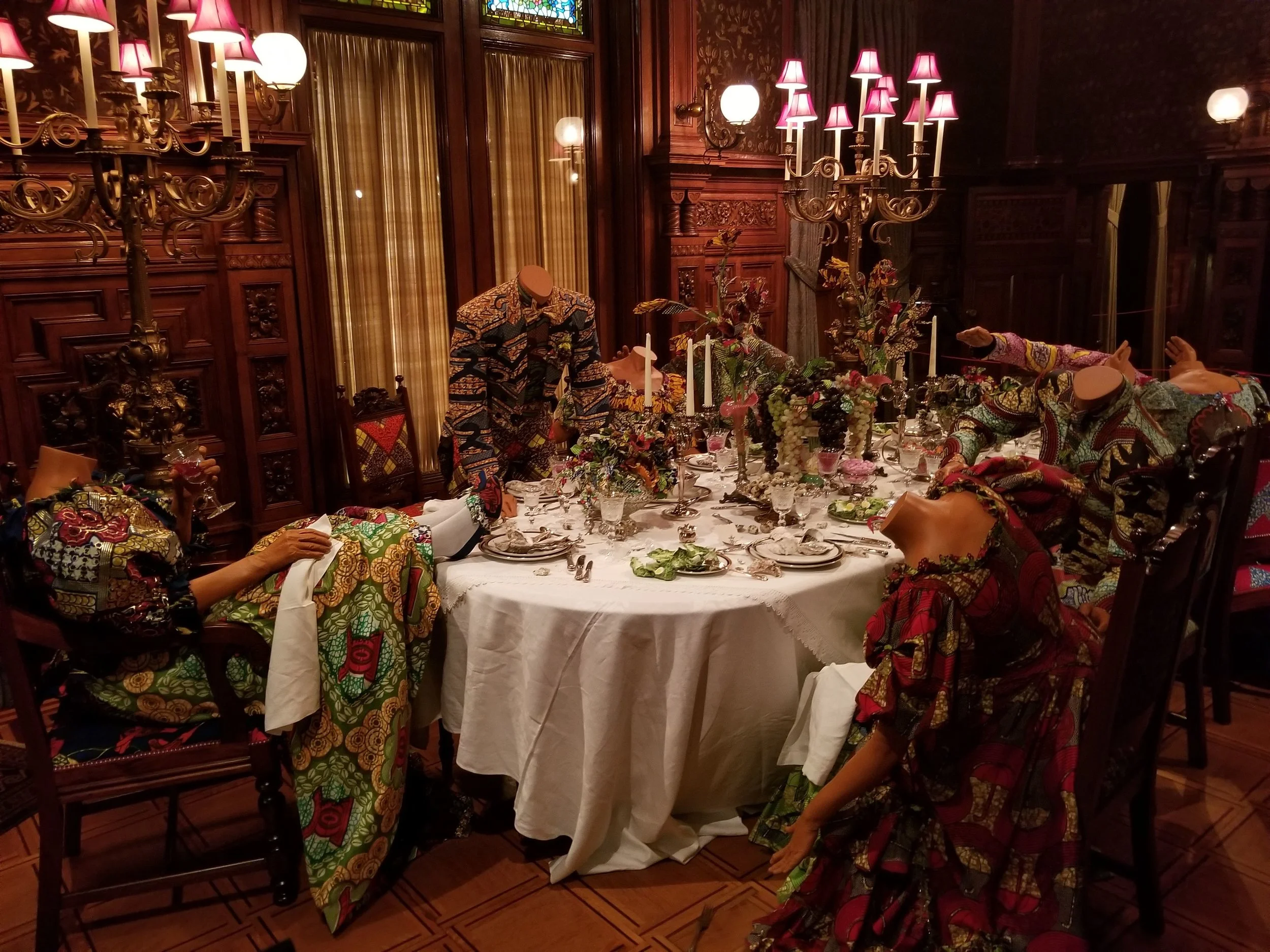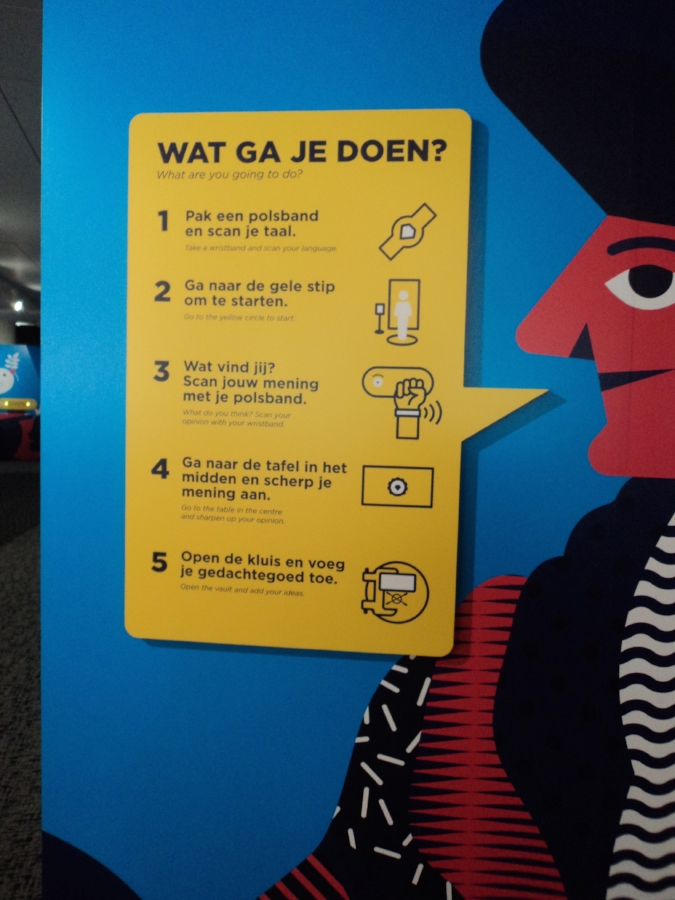Have you ever been to a Historic House Museum (HHM) where it wasn’t at all important to know who lived in the house before it became a museum? It seems almost antithetical to the concept—historic house museums have, traditionally, been set up to honor the people who lived in them, which often means rich, white men. It’s only recently that historic houses have embraced new philosophies on what they embody and display. When I went to Chicago this past weekend, I searched for historic sites or history museums that I hadn’t visited before. We did the obvious things, the Art Institute (Manet show!) and the Field Museum (boyfriend’s choice), but there was another museum that caught my eye: the Richard H. Driehaus Museum. It appeared to be a historic house, clearly a beautiful Gilded Age site. I saw that they had a Yinka Shonibare, CBE installation in their rooms. Sold!
The foyer of the Driehaus Museum. (My photo.)
We arrived at the Driehaus Museum in the middle of a rainstorm, and the staff ushered us back to the ticket counter. There, they had a small display about the people who had originally built and owned the house. Samuel Nickerson, first a liquor merchant and then a bank president, had built the house between 1879 and 1883 and spared no expense. He and his wife were art collectors, using the house as a gallery. When he died, the art collection went to the Art Institute, and after another private owner, a banker as well, the house was sold to the American College of Surgeons. That 1919 sale was an act of historic preservation, and then, in a second act of historic preservation, the house was sold to a philanthropist and collector named Richard Driehaus in 2013. Consequently, this museum is not a traditional HHM, but rather a showpiece of Driehaus’s dedicated restoration, a composite of the family histories and something else as well. It has been open for only about 11 years.
Before heading into the restored museum spaces, I had a moment of fear after reading about the building’s history—where’s the historical authenticity if a house is restored not to its original appearance, but to some in-between ideal of a funder? How does that affect the mission of the museum? Does presenting a restoration as thoroughly historic reflect a broader attitude toward representing “the way things were” in the house’s original time period. One particular differentiation from the original appearance of the house would be the prevalence of Tiffany light fixtures, apparently a focus of Mr. Driehaus’s collecting. However, the most exquisite Tiffany works were produced after Mr. Nickerson had died.
Yet it turns out that perhaps this model of HHM can be liberating. The museum did have notes about how Mr. and Mrs. Nickerson originally used the rooms. They also had fairly precise and careful indications, much more in the way of passive interpretation than I’ve seen at other HHMs, of what was original and what was restored. They also clearly felt free to comment on the institutions that gave way to the ability to create such a gem of a house in a city that has always been deeply stratified by class. The signs that discussed the restoration made clear that one difficulty had been cleaning the Berea sandstone exterior of the house; a century of industrial smog had to be carefully removed to find the underlying color.
However, they mixed that context with a powerful critique of how such institutions came to be, simply by allowing the contemporary to mix productively with the historic. Currently, the Driehaus Museum is playing host to an exhibit called A Tale of Today: Yinka Shonibare CBE. I’ve been fascinated by Shonibare’s work for a long time; I once wrote a paper that tried to compare his method of quoting art history to Edgar Degas’s. Shonibare, a British-Nigerian artist, borrows familiar tropes, plots, and visual configurations to disrupt the history of art from the inside out. Placing this exhibition in this kind of museum suggests that, by abandoning the strictures of one historic period, more thematic analyses are possible.
An excellent example of the clash between Shonibare and the traditional model of an HHM is Party Time: Reimagine America (2009), originally produced for the Newark Museum and on display here in the Nickersons’ dining room.
Party Time: Reimagine America (2009) installed in the Driehaus Museum. (My photo.)
The figures wear Dutch wax clothing, a critical signifier of colonialism in Shonibare’s visual language—the cloth, usually associated with Africa and imported into African markets, was actually made in the Netherlands. In Shonibare’s hands, it calls a viewer to consider who is really responsible for the societies that we inhabit. Party Time shows a dinner table full of people whose actions, like feet on the table, betray the exclusive and elite activities the circumstances are supposed to recall. The headless mannequins, nearly disembodied suits of clothes, also recall the ghosts of the people who once lived in the house, who likely had servants, and whose actions reified divisions of social class, race, and gender.
The Driehaus Museum was my most pleasant surprise of this trip to Chicago, the exact opposite of that moment of fear that had me rethinking all of my choices to go there. While I have been wary of contemporary art installations in historic settings in the past, the Shonibare exhibit enriched the experience of being in the museum. It gave me so much more than if the house had simply been full of the Nickerson furnishings or a museum to the surgeons who called it their professional home for a century, even if I would have happily gone to either. It might not be rocket science, or even the interventions spelled out in Anarchist’s Guide to Historic House Museums, but other museums could certainly learn from being so open to new ideas.





